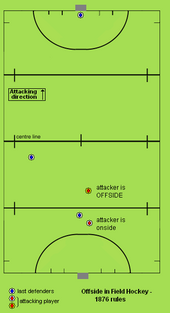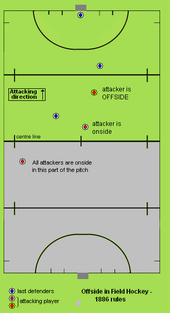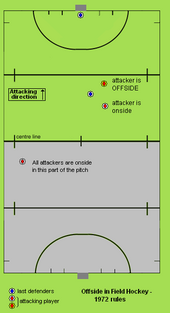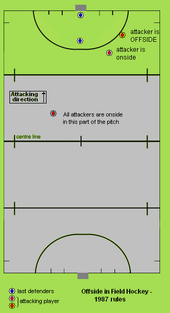Offside (field hockey) facts for kids
Imagine you're playing a game, and you're not allowed to stand too close to the opponent's goal before the ball gets there. That's kind of what an offside rule is! In field hockey, there used to be an offside rule, much like the one in soccer. This rule stopped attacking players from getting too far ahead of the ball. But guess what? Field hockey changed its rules over time, and the offside rule was completely removed in the mid-1990s.
Contents
A Look Back: Offside Rules in Field Hockey
Field hockey has changed a lot over the years. The offside rule is a great example of how sports rules can evolve to make the game better and more exciting.
The First Offside Rule: 1876
In January 1876, some hockey clubs in London created the first set of field hockey rules. These rules included an offside rule.
Here's how it worked:
- An attacking player was "offside" if they were closer to the opponent's goal than both the ball and at least three defenders.
- Think of it this way: if you were attacking, and the ball was behind you, and there were fewer than three defenders between you and the goal, you were offside!
- This rule applied all over the field, except when the ball was hit from the goal line.
Changes in 1886: The Halfway Line
In 1886, the main hockey group in England made new rules. They changed the offside rule to make the game flow a bit more.
- From then on, the offside rule only applied to attacking players once they crossed the halfway line. This meant players had more freedom in their own half of the field.
1972 Rule Update: Fewer Defenders Needed
The 1886 offside rule stayed the same for a long time! But in 1972, a small but important change happened:
- Instead of needing three defenders between an attacking player and the goal, only two defenders were needed to make a player "onside." This made it a little easier for attackers.
1987 Rule Update: The 25-Yard Area
More changes came in 1987 to speed up the game.
- The offside rule was changed again. Now, it only applied in the 25-yard area near the goal. This gave players much more space in the middle of the field.
Offside Rule Removed: A Big Change!
After all these changes, the offside rule was finally taken out of field hockey completely!
- "No offside" was first tried out as an experiment in 1996.
- It worked so well that it became a permanent rule in 1998.
Why did they get rid of it? The main goals were:
- To help the attacking team score more goals.
- To create more open space around the goal area and in the middle of the field.
- To make the game flow better, with fewer stops and whistles.
- To make the game more exciting for both players and fans!
This big change led to new ways of playing the game, as teams learned to use the extra space.
How the Offside Rule Changed (Visuals)





